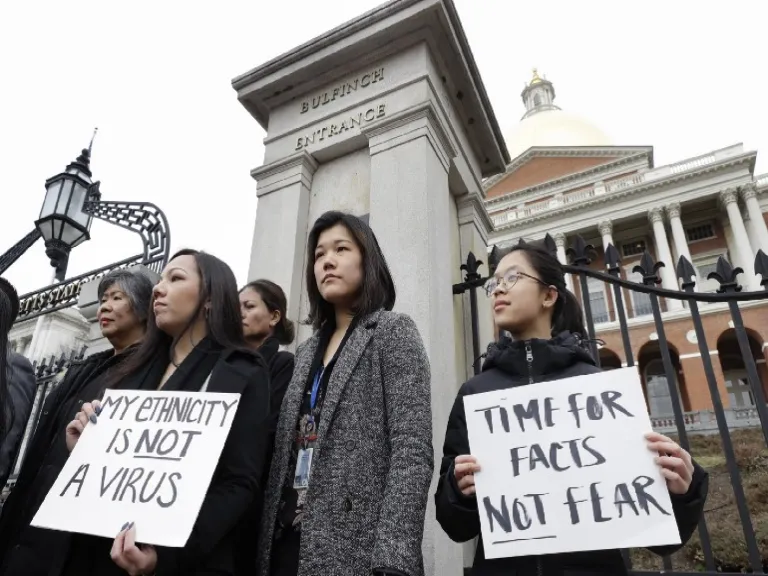
Why Violence Against Asians Has Been Long Overlooked
From micro-aggressive “nicknames” for the COVID-19 Virus such as Kung Flu and Chinese Virus to attacks against elderly Asian Americans and Canadians, anti-Asian violence has been on the rise, but media coverage has not. Even prior to the Coronavirus pandemic, anti-Asian violence has been overlooked, because of racial stereotyping and continuous racist and xenophobic rhetoric.
From micro-aggressive “nicknames” for the COVID-19 Virus such as Kung Flu and Chinese Virus to attacks against elderly Asian Americans and Canadians, anti-Asian violence has been on the rise, but media coverage has not. Even prior to the Coronavirus pandemic, anti-Asian violence has been overlooked, because of racial stereotyping and continuous racist and xenophobic rhetoric.
Image for post
Source: Rolling Stone through photographer Steven Senne
Recent anti-Asian Violence in the United States
In security footage from January 28th, 84 year-old Vicha Ratanapakdee was shoved to the ground while on his morning walk in San Francisco, by 19 year-old Antoine Watson. Two days later, Ratanapakdee passed away. Watson has since been charged with murder and elder abuse.
In San Jose, a 64 year-old Vietnamese grandmother was robbed of $1000 which she had taken out in preparation for Lunar New Year on February 12th. The perpetrators used their car to block hers, opened the door, and stole her purse. They have not yet been caught, and the San Jose police are searching for surveillance video.
On February 3rd, a Filipino man, 61 year-old Noel Quintana, was slashed across his face while commuting to one of his two jobs in Manhattan. He was attacked by a man on the subway who then fled when the train stopped at First Avenue and 14th Street. The perpetrator was last seen in a plain black mask and a black North Face jacket, and has not yet been arrested.
In Oakland Chinatown, a 91 year-old man was seen on camera being violently shoved to the ground by 28 year-old Yahya Muslim, who was charged with assault, battery, and elder abuse by the Oakland Police. According to the Chinatown Chamber of Commerce President, this suspect attacked several others (a 60 year-old man and a 55 year-old woman) that same day.
Since the beginning of the COVID-19 pandemic, Asian Americans have experienced elevated levels of racially motivated violence than in previous years. The NYPD reported that anti-Asian hate crimes in New York City jumped 1,900% during the year 2020. 58% of Asian Americans and 45% of African Americans believe that racist views toward them had increased since the pandemic, according to a June 2020 Pew Research study. Additionally, Stop AAPI Hate, a reporting database created at the beginning of the pandemic as a response to the increase in racial violence against Asian Americans and Pacific Islanders, received 2,808 reports of anti-Asian discrimination between March 19 and December 31, 2020.
Along with the documented instances of anti-Asian racism on the street, there are reports that many media outlets such as CNN, The Wall Street Journal, The Guardian, and Fox News capitalize on Sinophobia and Orientalist tropes that the Chinese are inherently sneaky and untrustworthy, and are ruled by an incompetent, authoritarian government. In response to the anti-Asian and anti-Chinese sentiment, individuals on social media have brought attention to the fact that it is counter-productive to blame Chinese people for the coronavirus, and reminded the public to avoid conflating the people of China with the Chinese government or Chinese Communist Party.
Recent anti-Asian Violence in Canada
On March 13 2020, a white man in his 50s yelled racist remarks about COVID-19 towards a 92-year-old Asian man with dementia at a convenience store in Vancouver. The suspect also assaulted the elderly man, which caused the victim to fall and hit his head on the ground.
In July 2020, Vancouver police charged a man in connection with the March 13 attack of a 92-year-old Asian man with dementia in a convenience store near Nanaimo Street. While police called the attack a hate crime, Jamie Bezanson was charged with assault.
On November 1 2020, a man was filmed threatening a Filipino man on a bus in Vancouver. The man referred to the Filipino man as a “Chinese spy” and threatened to sexually assault his daughter.
In Scarborough, Toronto, a maskless woman was filmed verbally attacking an Asian employee at a Shoppers Drug Mart. The woman yelled that she knew martial arts and that the employee did as well. The woman also held a tissue with her blood on it and threatened the worker with it.
According to the Vancouver Police Department, the number of anti-Asian hate crimes reported in the months March and April 2020 exceeded the total in 2019. During the first nine months of 2020, the number of anti-Asian hate crimes saw an 878% increase compared to the same period in 2019, from 9 to 88. A year-end report presented by the Vancouver Police Department to the police board Wednesday shows that anti-Asian hate crimes are up 717 per cent over the past year. The department’s figures show 98 anti-Asian hate crimes were reported in 2020, up from 12 incidents the year before. Overall, hate crimes increased 97 per cent, from 142 incidents in 2019 to 280 in 2020.
A national report, funded by the Government of Canada and conducted as a collaboration with the Chinese Canadian National Council — Toronto Chapter, Project 107, Vancouver Asian Film Festival and the Chinese Canadian National Council for Social Justice, revealed there were 600 documented anti-Asian incidents reported in the country since the start of the pandemic. It revealed that East Asians suffered the most attacks at 83%, followed by Southeast Asians at 7%, South Asians at 2%, mixed-race or biracial Canadians at 1.5% and Indigenous Canadians at 1%.
Although the United States has become infamous for its rampant and blatant racism, Canada is often no better, with the racially motivated attacks against Asian people being no exception.
Why have these attacks been rising?
Many people attribute the rise in violence against Asian Americans and Canadians to the racist rhetoric being spread by government officials; not just prominent figures such as the former President Donald Trump, but also by lower level administrators. Trump has been known to use racist descriptors for the COVID-19 virus, openly referring to it as the “China virus,” the, “Chinese virus,” and even the, “Kung flu.” In doing so, the former President normalized using the coronavirus to justify his and the country’s anti-Asian xenophobia, becoming the latest in a long American history to blame Asian people for viruses and diseases. These myths have helped to form the perception that Asian people are unwelcome foreigners, and have been doing so since the 19th and 20th centuries. However, smaller government officials and public figures have been making racist remarks over social media as well, helping to spread xenophobia on a more local level.
United States
At White House press conference on April 10th, Surgeon General Jerome Adams claimed that people of color were “socially predisposed” to coronavirus exposure. He also called on minority communities to abstain from drugs and alcohol with condescending language: “Do it for your abuela. Do it for your granddaddy, do it for your Big Mama, do it for your pop-pop.”
In mid-March 2020 in Miami Beach, Florida, a rapper named 1KJohnny posted an Instagram video of himself bullying an elderly Asian woman by chasing her with hand sanitizer while shouting, “Sanitize your ass!”
In late March 2020, Scottsdale, Arizona city council member Guy Phillips made a private Facebook post saying COVID stands for “Chinese Originated Viral Infectious Disease”, prompting criticism and allegations of racism.
A police officer in Kaplan, Louisiana, was fired for allegedly making comments on social media about it being “unfortunate” that more black people don’t die from COVID-19.
Canada
On 26 January 2020, Peter Akman, a reporter who was with CTV News, tweeted an image of his Asian barber in a mask and said, “Hopefully all I got today was a haircut.” He was fired after the tweet was reported for racism.
In May 2020, a Chilliwack, British Columbia School District trustee Barry Neufeld posted transphobic remarks about COVID-19 towards Theresa Tam on Facebook, after the Chief Public Health Officer spoke out, tweeting that she was, “concerned about the growing number of reports of racism and stigmatizing comments on social media directed to people of Chinese and Asian descent related to 2019-nCoV coronavirus.”
In April 2020, Dipanjan Basu, a University of Waterloo engineering professor posted anti-Chinese messages regarding the coronavirus on his personal Facebook account, for which he later apologized.
Why have the attacks been overlooked?
From Time Magazine’s Viet Thanh Nguyen: The basis of anti-Asian racism is that Asians belong in Asia, no matter how many generations we have actually lived in non-Asian countries, or what we might have done to prove our belonging to non-Asian countries if we were not born there. Pointing the finger at Asians in Asia, or Asians in non-Asian countries, has been a tried and true method of racism for a long time; in the United States, it dates from the 19th century.
Anti-Asian sentiment is not new in North America, it has been present for as long as Asian people have immigrated to Canada and the United States. It was popularized by the COVID-19 pandemic, but has always been present, so why is the general public so oblivious to the violence that this community faces?
Racially motivated violence against Asians has been disregarded for decades, largely due to the model minority myth, which, as the name suggests, is a falsehood created during the Civil War era to divide people of colour from each other and prevent racial justice movements. The model minority myth suggests that Asian Americans are more successful because they work harder, abide by the law, and are more educated than other ethnic minorities. Since the model minority myth suggests success, it has created the fallacy that Asian immigrants are not subject to race-related struggles or discrimination. This false phenomenon has been reinforced by limited and flawed media representation.
In reality, the Asian Americans has the largest wealth gap of any other diaspora in the United States. A 2018 study by the Pew Research Center found that Asian Americans experience the largest income inequality gap as an ethnic and racial group in the U.S. and a 2016 report from NYC Mayor’s Office of Operations found that Asian immigrants have the highest poverty rates in the city.
The model minority myth minimizes the racial struggles that Asian people face in North America, culminating in numerous violent attacks over nearly 12 months that have only recently been addressed.
What can you do?
Although we, as individuals, cannot abolish centuries-old racist rhetoric or harmful stereotypes, we can combat anti-Asian racism in our daily lives using education and allyship:
Education: Learning about the ways that racism presents itself will help to recognize and prevent it. The root of racism is denial; there is no way to change something that you refuse to acknowledge, thus, the first step toward anti-racism is educating yourself about how racist rhetoric and stereotypes circulate, keeping up to date on anti-Asian events such as those listed above, and learning about the historical context of anti-Asian racism. Education is a long term solution that will help to cement the place of Asian people as fellow Americans and Canadians instead of as perpetual foreigners.
Allyship: Anti-racism is a conscious practice. Setting intentions to be anti-racist in everyday actions is a habit much like any other, and taking actions with this intention in mind will help to integrate the mindset into daily life. From d

- Here are some tips on how to create an effective home workout. Youll learn to think like a trainer and build an effective workout routine

- Sony makes minority investment in Discord following halt in Microsoft buyout talks The companies are working to integrate Discord

- This Saturday afternoon, Queen Elizabeth II will bury her husband Prince Philip, the Duke of Edinburgh. The ceremony will

- it is exhibiting mercy, permit him get it done cheerfully. Salesforce PDI Dumps (Romans Salesforce Platform Developer I Platform Developer I Exam twelve